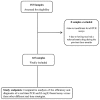Comparative Study of a Real-Time PCR Assay Targeting senX3-regX3 versus Other Molecular Strategies Commonly Used in the Diagnosis of Tuberculosis
- PMID: 26600434
- PMCID: PMC4658205
- DOI: 10.1371/journal.pone.0143025
Comparative Study of a Real-Time PCR Assay Targeting senX3-regX3 versus Other Molecular Strategies Commonly Used in the Diagnosis of Tuberculosis
Abstract
Background: Nucleic acid amplification tests are increasingly used for the rapid diagnosis of tuberculosis. We undertook a comparative study of the efficiency and diagnostic yield of a real-time PCR senX3-regX3 based assay versus the classical IS6110 target and the new commercial methods.
Methods: This single-blind prospective comparative study included 145 consecutive samples: 76 from patients with culture-confirmed tuberculosis (86.8% pulmonary and 13.2% extrapulmonary tuberculosis: 48.7% smear-positive and 51.3% smear-negative) and 69 control samples (24 from patients diagnosed with non-tuberculous mycobacteria infections and 45 from patients with suspected tuberculosis which was eventually ruled out). All samples were tested by two CE-marked assays (Xpert®MTB/RIF and AnyplexTM plus MTB/NTM) and two in-house assays targeting senX3-regX3 and the IS6110 gene.
Results: The detection limit ranged from 1.00E+01 fg for Anyplex, senX3-regX3 and IS6110 to 1.00E+04 fg for Xpert. All three Xpert, senX3-regX3 and IS6110 assays detected all 37 smear-positive cases. Conversely, Anyplex was positive in 34 (91.9%) smear-positive cases. In patients with smear-negative tuberculosis, differences were observed between the assays; Xpert detected 22 (56.41%) of the 39 smear-negative samples, Anyplex 24 (61.53%), senX3-regX3 28 (71.79%) and IS6110 35 (89.74%). Xpert and senX3-regX3 were negative in all control samples; however, the false positive rate was 8.7% and 13% for Anyplex and IS6110, respectively. The overall sensitivity was 77.6%, 85.7%, 77.3% and 94.7% and the specificity was 100%, 100%, 90.8% and 87.0% for the Xpert, senX3-regX3, Anyplex and IS6110 assays, respectively.
Conclusion: Real-time PCR assays targeting IS6110 lack the desired specificity. The Xpert MTB/RIF and in-house senX3-regX3 assays are both sensitive and specific for the detection of MTBC in both pulmonary and extrapulmonary samples. Therefore, the real time PCR senX3-regX3 based assay could be a useful and complementary tool in the diagnosis of tuberculosis.
Conflict of interest statement
Figures




References
-
- World Health Organization. Global tuberculosis report 2014. WHO/HTM/TB/2014.23. Available:http://apps.who.int/iris/bitstream/10665/137094/1/9789241564809_eng.pdf?....
-
- Behr MA, Warren SA, Salamon H, Hopewell PC, Ponce de Leon A, Daley CL, et al. Transmission of Mycobacterium tuberculosis from patients smear negative for acid-fast bacilli. Lancet 1999;353: 444–449. - PubMed
-
- Getahun H, Harrington M, O'Brien R, Nunn P. Diagnosis of smear-negative pulmonary tuberculosis in people with HIV infection or AIDS in resource-constrained settings: informing urgent policy changes. Lancet. 2007;369: 2042–9. - PubMed
Publication types
MeSH terms
Substances
LinkOut - more resources
Full Text Sources
Other Literature Sources
Medical
Molecular Biology Databases

